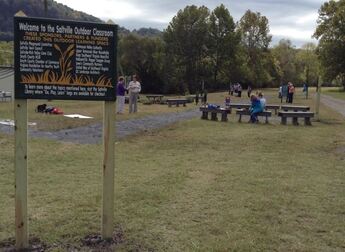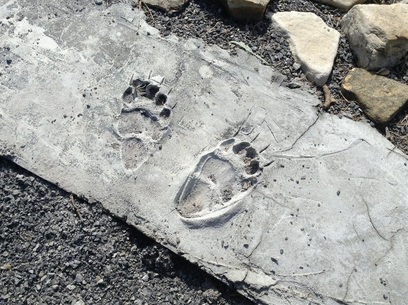Education and Outreach
Do you enjoy learning about nature? The Roundtable helps create outdoor education sites for the purpose of environmental education. In 2020, the Roundtable is creating an outdoor classroom at the Abingdon Community Center with funding from Dominion Charitable Foundation and with help from Wolf Hills Community School. Previously, the Roundtable helped develop the Saltville Outdoor Classroom in Smyth County, the Stone Creek Outdoor Classroom and Community Park in Lee County, and the Clear Creek Outdoor Classroom in the City of Norton. The Roundtable started a new classroom in Richlands that will be part of a town walking trail.
Upper Tennessee River Roundtable offers education and outreach programs, including two Conservation Camps for third graders, including one for Washington County and one for Smyth County. The Roundtable coordinates Guest River Education Day for Norton, which is similar to the Conservation Camps.
Another lesson source is a website by the Clinch River Valley Initiative: www.teachtheclinch.com, which can be adapted to other watersheds.
Upper Tennessee River Roundtable offers education and outreach programs, including two Conservation Camps for third graders, including one for Washington County and one for Smyth County. The Roundtable coordinates Guest River Education Day for Norton, which is similar to the Conservation Camps.
Another lesson source is a website by the Clinch River Valley Initiative: www.teachtheclinch.com, which can be adapted to other watersheds.
Who Polluted the River?
Richlands Outdoor Classroom
Upper Tennessee River Roundtable launched the development of an outdoor classroom in Richlands on the Clinch River. These three education signs are posted there where the town is creating a walking trail. The Roundtable restored this section of the river, stabilized the streambanks and planted a riparian buffer. The cleanup photo at the bottom of the programs page features one of the photos taken of a huge cleanup coordinated by the Roundtable and Keep Southwest Virginia Beautiful prior to the restoration project.
Stone Creek Outdoor Classroom and Community Park
|
The Stone Creek Outdoor Classroom and Community Park located at the corner of Routes 421 and 606 near Pennington Gap has eight learning stations and is available for school field trips. The litter timeline lesson featured above is included at the Stone Creek Community site as well as these topics:
|
Saltville Outdoor Classroom
|
The Saltville Outdoor Classroom located in Saltville, Virginia offers eight learning stations and is available for school field trips. Be sure to visit the Saltville Library to check out the "Go, Play, Learn" bags with many activities for parents and children to do at the classroom. The following topics are featured at the classroom.
|
WatershedCan you describe or give a definition for watershed? A watershed is land that drains rain and snow to a stream, lake, river, bay or ocean. We all live in watersheds. The larger watershed for our region is called Upper Tennessee River Watershed.
This link will take you to a lesson about how water travels through a watershed. |
Life Cycles of AnimalsDo you ever see animal tracks such as those in the photo? Can you figure out which animals made the tracks that you saw?
|
Plant Life CyclesPlants and trees are very important in nature.
Check out the Penn State website that has a lot of lessons about trees: |
Litter Prevention and RecyclingLitter is not only unsightly, but also littering is against the law. Hold onto all trash until you reach a trash can or a recycling bin.
The sign in the photo shows how long it takes for litter to decompose, rot, or go away if left on the ground. Some materials, such as plastic, take a very long time to decompose. The Virginia Department of Environmental Quality offers a variety of lessons in "Pollution Solutions." Visit this website to see the lessons: |
Did you know that your pet's waste can be harmful if washed into waterways?
Click to download PDF of each.
Acid Mine Drainage
A key concern of the Roundtable is Acid Mine Drainage. The Roundtable created a flier that highlights the harm of AMD and also serves as a field guide for identifying water sources affected by AMD. Click here to download the flier in PDF format.
Asbestos Recycling Resource
Asbestos was used from the 1930s until the late 1970s to make thousands of products. AS these products are used or worn down, they can send stray asbestos fibers into the air. Inhaling or swallowing asbestos fibers can cause mesothelioma or other disease later in life. Luckily, asbestos can be recycled into a harmless glass with the help of professional abatement teams.












